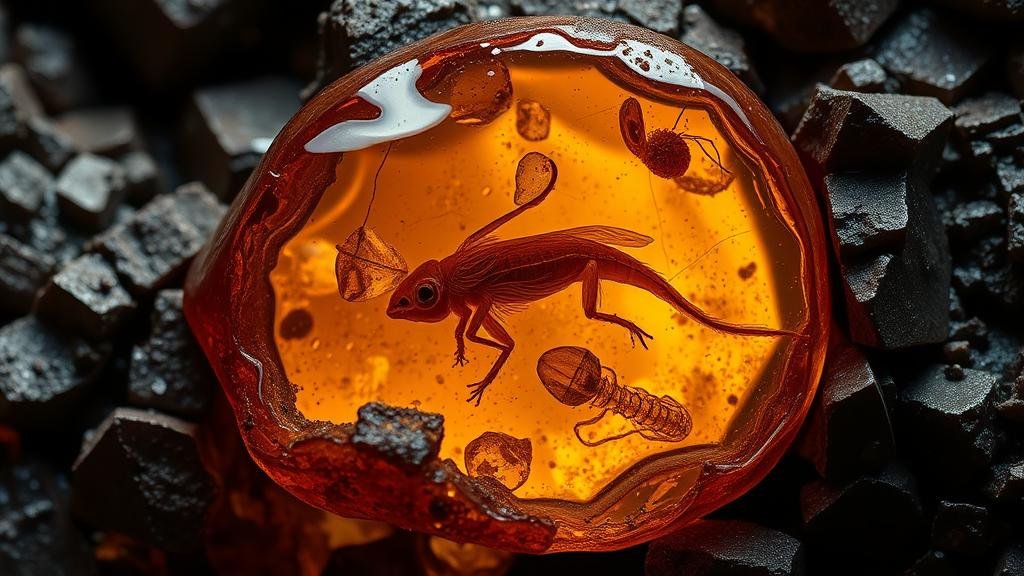Investigating amber deposits in the Dominican Republic for ancient biological inclusions.
Investigating Amber Deposits in the Dominican Republic for Ancient Biological Inclusions
The Dominican Republic is renowned for its rich amber deposits, primarily sourced from the Miocene epoch, which spans from about 23 to 5 million years ago. These deposits continuously attract rockhounds and mineral collectors interested in the historical and biological significance of amber. This article delves into the origins, compositions, and collection tips for Dominican amber, highlighting its fascinating inclusions that offer a glimpse into ancient ecosystems.
The Origins of Dominican Amber
Dominican amber is primarily derived from the resin of the Hymenaea protera tree, a prehistoric tree species that thrived in tropical environments. This amber is particularly valuable due to its clarity, color range, and the remarkably well-preserved biological inclusions often found within it. It is estimated that about 90% of the worlds amber specimens come from the Dominican Republic, showcasing a wide array of ancient flora and fauna.
The Composition and Properties of Dominican Amber
The chemical composition of Dominican amber is predominantly succinite, which is a specific type of amber characterized by its high content of succinic acid. Typically, Dominican amber exhibits a hardness of 2 to 2.5 on the Mohs scale, making it relatively easy to carve yet durable enough to sustain minor wear. Its optical properties are also noteworthy; light can pass through amber, revealing a warm, golden glow that enhances the visual appeal of even the smallest specimens.
Biological Inclusions: A Window to the Past
The extraordinary inclusions within Dominican amber consist of plant matter, insects, and other organisms that were trapped in the resin before it hardened. Such inclusions provide vital insights into paleoecology, helping scientists understand ancient ecosystems. Notable inclusions include:
- Various insect species (e.g., ants, mosquitoes)
- Plant fragments (e.g., leaves, pollen)
- Small vertebrates, such as lizards and frogs
There have been findings of inclusions with exceptional preservation, allowing scientists to perform genetic analyses. For example, studies have successfully extracted DNA from encapsulated insects, offering hints about their evolutionary lineage.
Exploring Amber Deposits: Tips for Collectors
For those interested in collecting Dominican amber, there are several strategies one should employ to maximize their experience and success:
- Visit Established Mines: Popular sites such as the Mount Isabel de Torres area and La Cumbre offer guided tours and access to quality specimens.
- Research Local Regulations: Ensure compliance with local laws governing amber collection to promote sustainable practices.
- Inspect Amber Thoroughly: Look for signs of organic inclusions under sunlight, as certain inclusions may be more pronounced when illuminated.
- Network with Other Collectors: Join local rockhounding groups or online communities to exchange tips and potentially trade specimens.
Collectors should look for specific traits, such as clarity, color, and inclusiveness, which can significantly affect value. Rare colors, such as blue or green amber, are particularly sought after and can command higher prices in the market.
Challenges and Considerations in Amber Collection
While Dominican amber is a treasure trove for collectors, challenges abound. The collection of amber, particularly from tourist sites and mines, can lead to environmental degradation if not conducted responsibly. Also, counterfeit amber is prevalent; thus, knowledge of authentic versus synthetic pieces is essential. Collectors should consider:
- Investing in authenticity certifications when purchasing high-value specimens.
- Learning to differentiate between real amber and copal, a much younger and less valuable resin.
Actionable Takeaways for Aspiring Collectors
Venturing into the world of Dominican amber deposits can be both an enriching and educational experience. Here are key takeaways for collectors:
- Conduct thorough research on Dominican amber and its significance in paleontology.
- Respect local environmental guidelines when exploring collection sites.
- Engage with experienced collectors to enhance your knowledge and collection techniques.
By understanding the geological and biological context of Dominican amber, rockhounds and mineral collectors can deepen their appreciation for these ancient treasures and contribute to the preservation of our planets rich fossil history.


